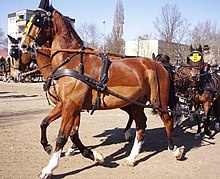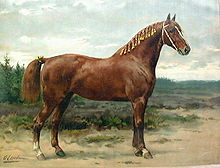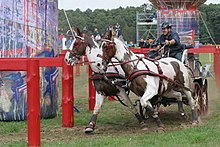 In harness, four-in-hand In harness, four-in-hand | |
| Conservation status | |
|---|---|
| Other names | Gelders Paard |
| Country of origin | Holland |
| Traits | |
| Weight |
|
| Height |
|
The Gelderlander is a Dutch breed of warmblood horse. It was bred in the province of Gelderland in the Netherlands as a carriage horse capable also of farm work. It declined in popularity in the mid-twentieth century. In 1965 it was one of the foundation breeds of the Dutch Warmblood or KWPN, the other being the heavier Groninger horse from the north. It is registered in a division of the Royal Dutch Warmblood Horse Studbook, which also has divisions for the Dutch Warmblood and for the Dutch Harness Horse.
It is an endangered breed; in 2017 the breeding population numbered 600 mares and 35 stallions.
History


The Gelderlander was bred from the late nineteenth century in the province of Gelderland in the Netherlands as a carriage horse capable also of farm work, and with some capability as a heavy riding horse. Local mares were cross-bred with imported stallions of a wide range of breeds and types, among them Alt-Oldenburger and Ostfriesen, Anglo-Arab, Arab, Cleveland Bay, English half-bred, Furioso, Hackney, Nonius, Norfolk Roadster, Orlov and Orlov-Rostopchin.
In 1969 the Vereniging tot bevordering van de Landbouwtuigpaardenfokkerij in Nederland, which registered the Gelderlander, was merged with the Nederlands Warmbloed Paard studbook, which registered the Groninger, to form the Koninklijk Warmbloed Paardenstamboek Nederland or "Royal Warmblood Horse Studbook of the Netherlands". Three breed types were registered in the stud-book: riding horses (the Dutch Warmblood); harness horses (the Dutch Harness Horse); and the Gelderlander.
In 2005 a new breeders' association, the Gelderlander Paard Associatie, was formed to preserve the original type of the Gelderlander.
Characteristics
The Gelderlander is most often chestnut, often with extensive white markings. Males usually stand about 168 cm at the withers, mares a few centimetres less.
Uses

The Gelderlander is much used in competitive carriage driving; it jumps well and reliably but is not fast.
Notes
- roughly "association for the promotion of agricultural harness horse breeding in Holland"
References
- ^ Barbara Rischkowsky, Dafydd Pilling (editors) (2007). List of breeds documented in the Global Databank for Animal Genetic Resources, annex to The State of the World's Animal Genetic Resources for Food and Agriculture. Rome: Commission on Genetic Resources for Food and Agriculture, Food and Agriculture Organization of the United Nations. ISBN 9789251057629. Archived 23 June 2020.
- ^ Breed data sheet: Gelders Paard / Netherlands (Horse). Domestic Animal Diversity Information System of the Food and Agriculture Organization of the United Nations. Accessed September 2021.
- ^ Valerie Porter, Lawrence Alderson, Stephen J.G. Hall, D. Phillip Sponenberg (2016). Mason's World Encyclopedia of Livestock Breeds and Breeding (sixth edition). Wallingford: CABI. ISBN 9781780647944.
- S.J. Hiemstra (editor) (2002). National Report on Animal Genetic Resources, the Netherlands. The Hague: Ministry of Agriculture, Nature Management and Fisheries. Archived 9 September 2021. Annex to: Barbara Rischkowsky, Dafydd Pilling (editors) (2007). The State of the World's Animal Genetic Resources for Food and Agriculture. Rome: Commission on Genetic Resources for Food and Agriculture, Food and Agriculture Organization of the United Nations. ISBN 9789251057629. Archived 10 January 2017.
- Élise Rousseau, Yann Le Bris, Teresa Lavender Fagan (2017). Horses of the World. Princeton: Princeton University Press. ISBN 9780691167206.
- ^ Elwyn Hartley Edwards (1994). The Encyclopedia of the Horse. London; New York; Stuttgart; Moscow: Dorling Kindersley. ISBN 0751301159.
- Gelderland. Lexington, Kentucky: International Museum of the Horse. Archived 12 January 2009.
- ^ Elwyn Hartley Edwards (2016). The Horse Encyclopedia. New York, New York: DK Publishing. ISBN 9781465451439.
- Historie (in Dutch). Koninklijk Warmbloed Paardenstamboek Nederland. Accessed October 2021.
- Doelstelling Gelderlander Paard Associatie (in Dutch). Babberich, Gelderland: Gelderlander Paard Associatie. Accessed August 2023.